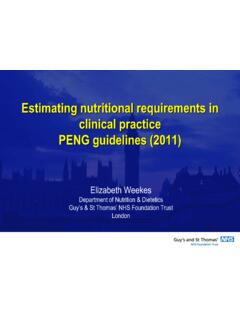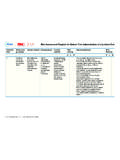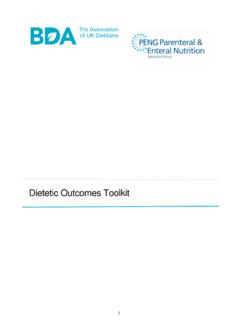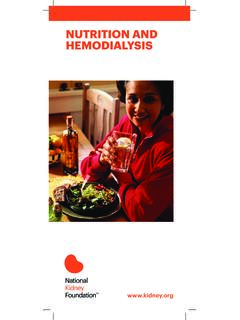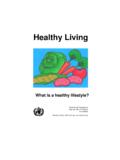Transcription of Healthy Eating for People with an Ileostomy
1 Healthy Eating for People with an Ileostomy After formation of your Ileostomy you will continue to digest and absorb all nutrients normally in your small bowel. Resection of your large bowel results in you absorbing less water and salt, so you will initially experience quite a liquid output from your Ileostomy . However, with time your body will adapt to absorb more water and salt so your Ileostomy output will become thicker. You can maintain good health by taking a varied diet with an adequate amount of fluid and salt.
2 This leaflet contains: Information about the reintroduction of food for those with a new Ileostomy Guidelines to help you choose a Healthy diet Guidance about diet in relation to developing acceptable Ileostomy function Whilst the experience of others may serve as a guide, remember that as an individual you may respond differently to food, both before and after surgery, and therefore you should base food choices on your own personal tolerance. Please note that the advice in this booklet is not suitable for those with short bowel or intestinal failure.
3 If you are unsure, please consult your doctor, stoma care nurse or dietitian. Reintroduction of food after formation of a new Ileostomy After surgery it is important to take a well-balanced diet to help with healing. As with any operation, you may find that it takes time for your appetite to return, especially if you were unwell before surgery. It is a good idea to reintroduce food gradually, starting with a soft, nutritious diet which is easy to digest: Include protein foods such as meat, fish, eggs, cheese and milk to help wound healing.
4 Eat carbohydrates such as white bread, low fibre cereals like rice krispies or cornflakes, potatoes (no skins) and white rice/pasta for energy. If your appetite is poor, take smaller meals with snacks in-between, such as cereal, sandwiches, cheese and crackers, yoghurts or nutritious drinks like milk or other supplements which may be recommended by your dietitian. Choose plainly cooked foods and avoid spicy or highly seasoned dishes, fried foods and fibrous foods. Eat slowly and chew your food well.
5 Nutrition and Dietetic Department, St Mark s Hospital, Tel: 0208 869 2666 Information for Patients Fibrous foods which should be avoided Fibrous foods are difficult to digest and may cause blockage if they are eaten in large quantities or are not properly chewed, so for the first six to eight weeks after your operation you should avoid: Nuts Pith Raw vegetables Mushrooms Coconut Seeds Fruit or vegetable skins Salad Celery Pineapple Pips Peas Sweetcorn Dried fruit Mango Once your Ileostomy has settled (approximately six to eight weeks) you may reintroduce fibrous foods in small quantities, ensuring that they are all well chewed.
6 Fluids and Salt It takes time for your Ileostomy to adapt and you may experience a loose, liquid output for several weeks. During this time you may be losing more fluid and salt than is normal and therefore be at risk of becoming dehydrated. To prevent this you should ensure that you have an adequate fluid and salt intake: Aim for at least 8-10 cups of fluid per day ( litres) including water, tea, coffee and squashes. Add extra salt to your meals. Half to one teaspoon of salt spread evenly throughout the day should be adequate.
7 If your output is high or you become dehydrated, your doctor may prescribe an oral rehydration solution for you, St Mark s Electrolyte Mix. Please ask your doctor, stoma nurse or dietitian for further advice. As your Ileostomy settles your output will become thicker but you should continue to ensure you have an adequate fluid and salt intake. Healthy Eating for People with an established Ileostomy Once your Ileostomy begins to adapt and you become used to its normal function, you will feel more confident to experiment with food, and many People find they can enjoy the freedom of a full and varied diet.
8 Choosing a Healthy diet No one food contains all the nutrients needed for health so you should choose a variety of foods from each of the following groups to achieve an adequate intake (this may be modified by your dietitian if you are under or over weight). Starchy Foods These provide energy, vitamins and fibre. Examples include: Bread, chapattis Breakfast cereals, oats Pasta Rice Potatoes, sweet potatoes Noodles Plantains, green bananas, yam Dishes made with maize, millet and corn meal These foods are reported to help thicken Ileostomy output, so include a variety of foods from this group and make them the main part of your meals.
9 The low fibre versions are better tolerated so try white bread, breakfast cereals like rice krispies or cornflakes, white rice/pasta, and avoid skins on potatoes. Protein Foods These provide protein, vitamins and minerals which is essential for health and repair of body tissues. Examples include: Meat- beef, pork, bacon, lamb, liver, kidney Poultry- chicken, turkey Fish Eggs Beans, baked beans, peas, lentils Nut products- peanut butter, ground nuts Meat alternatives- textured vegetable protein, quorn, and tofu.
10 Include two portions from this list each day. Try to cook foods without adding extra fat. Red meats, liver, kidney, oily fish, eggs and pulses are good sources of iron so try to include these regularly. Dairy Produce Dairy products are a good source of calcium which is important for Healthy bones. These foods also provide protein and some vitamins. Try to take to 1 pint (300-600ml) of milk per day or its equivalent as cheese or yoghurt. One cup of milk (1/3 pint/ 200ml) contains the same amount of calcium as one small carton of yoghurt (5oz/ 150ml) or 1oz/ 30g of cheese, so these may be taken as alternatives to milk.
